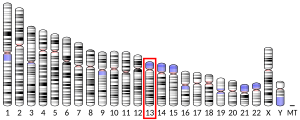GSX1
GS homeobox 1 (GSX1) is a protein encoded by the gene of the same name, located on chromosome 13 in humans[5] and chromosome 5 in mice.
GSX1 is part of the homeobox gene family and acts as a transcription factor. It is essential for the expression of growth hormone-releasing hormone (GHRH)[6] and is crucial for the development of neurons involved in sensory processing, particularly in prepulse inhibition.[7]
Additionally, GSX1 is implicated in spinal cord injury recovery, promoting neural stem cell proliferation and enhancing locomotor function in injured mice.[8]
Structure
[edit]GSX1 is a polypeptide chain consisting of 264 amino acids, with a molecular weight of 27,833 Da.[9] The GSX1 protein contains a homeodomain, a conserved protein domain that facilitates binding to double-stranded DNA, suggesting its role as a transcription factor.[10]
Gene Location
[edit]The GSX1 gene is located on the short arm of chromosome 13 at the cytogenetic band 13q12.3. It is part of a larger family of homeobox genes, which are crucial for developmental processes and the regulation of gene expression during embryonic development.[5]
Function
[edit]GSX1 is classified as an activator and developmental protein. It plays a significant role in various biological processes, including transcription and transcription regulation. The protein features a DNA-binding domain and is predominantly localized in the cell nucleus, where it influences the expression of target genes.[11]
Growth hormone-releasing hormone
[edit]One of the key functions of GSX1 is its involvement in the expression of the growth hormone-releasing hormone (GHRH) gene. Research indicates that GSX1, known as Gsh-1 in mice, is essential for GHRH gene expression.
A study demonstrated that the absence of Gsh-1 in knockout mice resulted in a dwarf phenotype and a complete loss of GHRH expression. This study elucidated that GSX1 binds to multiple regulatory sites in the GHRH promoter, enhancing its transcriptional activity, especially in the presence of CREB-binding protein, indicating a cooperative regulatory mechanism within the hypothalamus.[6]
Prepulse inhibition in the brain
[edit]GSX1 plays a critical role in the development of specific neurons involved in sensory processing and cognitive regulation. Research has shown that GSX1-expressing neurons are essential for prepulse inhibition, a mechanism that helps the brain filter out irrelevant information and prevent cognitive overload. In studies using larval zebrafish and GSX1 knockout mice, the absence or silencing of these neurons resulted in significant impairments in prepulse inhibition, because they are involved in initiating startle responses.[7]
Applications
[edit]Spinal Cord Injury
[edit]GSX1 has been implicated in tissue regeneration strategies, particularly in the context of spinal cord injury (SCI).
Promoting resident cells, especially neural stem and progenitor cells (NSPCs), is a potential approach for treating SCI. However, adult NSPCs primarily differentiate into glial cells (a type of brain cell that's not a neuron and helps support neural structure), contributing to glial scar formation at injury sites, which isn't useful.[12]
GSX1, in its developmental role, regulates the generation of excitatory and inhibitory interneurons during spinal cord embryonic development.
Recent studies show that lentivirus-mediated expression of GSX1 increases the number of NSPCs in a mouse model of SCI during shortly after injury. This expression subsequently boosts the generation of glutamatergic and cholinergic interneurons while decreasing the production interneurons that produce GABA in the long term. [8]
This ultimately means that GSX1 expression reduces reactive astrogliosis and glial scar formation, enhances serotonin neuronal activity, and improves locomotor function in injured mice, leading to better long-term outcomes.[8]
References
[edit]- ^ a b c GRCh38: Ensembl release 89: ENSG00000169840 – Ensembl, May 2017
- ^ a b c GRCm38: Ensembl release 89: ENSMUSG00000053129 – Ensembl, May 2017
- ^ "Human PubMed Reference:". National Center for Biotechnology Information, U.S. National Library of Medicine.
- ^ "Mouse PubMed Reference:". National Center for Biotechnology Information, U.S. National Library of Medicine.
- ^ a b "HUGO Gene Nomenclature Committee, HGNC:20374". Retrieved 2017-09-20.
- ^ a b Mutsuga N, Iwasaki Y, Morishita M, Nomura A, Yamamori E, Yoshida M, et al. (December 2001). "Homeobox protein Gsh-1-dependent regulation of the rat GHRH gene promoter". Molecular Endocrinology. 15 (12): 2149–2156. doi:10.1210/mend.15.12.0747. PMID 11731616.
- ^ a b Bergeron SA, Carrier N, Li GH, Ahn S, Burgess HA (2015-08-01). "Gsx1 expression defines neurons required for prepulse inhibition". Molecular Psychiatry. 20 (8): 974–985. doi:10.1038/mp.2014.106. ISSN 1476-5578. PMC 4362800. PMID 25224259.
- ^ a b c Patel M, Li Y, Anderson J, Castro-Pedrido S, Skinner R, Lei S, et al. (2021-08-04). "Gsx1 promotes locomotor functional recovery after spinal cord injury". Molecular Therapy. 29 (8): 2469–2482. doi:10.1016/j.ymthe.2021.04.027. ISSN 1525-0016. PMC 8353206. PMID 33895323.
- ^ "UniProt, Q9H4S2". Archived from the original on 2017-10-03. Retrieved 2017-09-20.
- ^ "GSX1_HUMAN". UniProt. Q9H4S2.
- ^ "GSX1 GS homeobox 1 [Homo sapiens (human)] - Gene - NCBI". www.ncbi.nlm.nih.gov. Retrieved 2024-10-14.
- ^ Pang QM, Chen SY, Xu QJ, Fu SP, Yang YC, Zou WH, et al. (2021-12-02). "Neuroinflammation and Scarring After Spinal Cord Injury: Therapeutic Roles of MSCs on Inflammation and Glial Scar". Frontiers in Immunology. 12. doi:10.3389/fimmu.2021.751021. ISSN 1664-3224. PMID 34925326.




